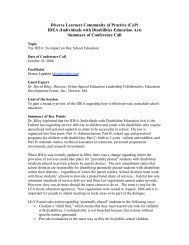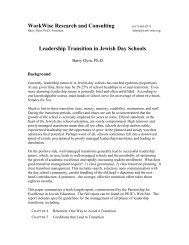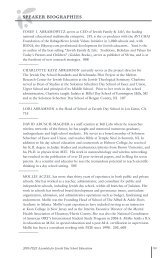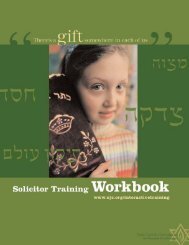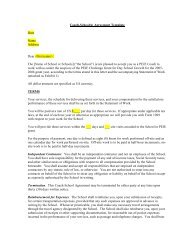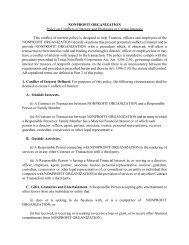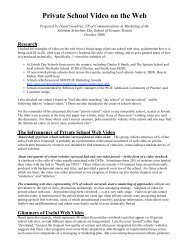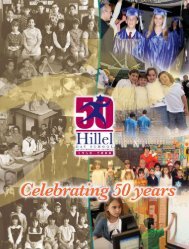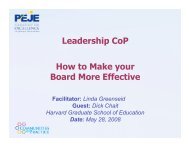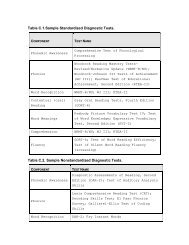WHO IS AN EDUCATED JEW?A historical perspective on the <strong>Jewish</strong> canon, andreflections on what today’s learned Jews need to knowPaula Hyman • Repr<strong>in</strong>ted with permission from Sh’ma: A Journal <strong>of</strong> <strong>Jewish</strong> Responsibility (http://www.shma.com) Feb., 2002.Paula E. Hyman is Lucy MosesPr<strong>of</strong>essor <strong>of</strong> Modern <strong>Jewish</strong> Historyat Yale University.Hebrew is an essential tool<strong>for</strong> read<strong>in</strong>g much <strong>of</strong> what<strong>Jewish</strong> culture has produced.But it is more than a tool.Without Hebrew there is novisceral, as dist<strong>in</strong>ct from<strong>in</strong>tellectual, connection to<strong>Jewish</strong> creativity across timeand space.There has been no consensus on the issue <strong>of</strong> “Who is an educatedJew?” <strong>for</strong> more than two hundred years. If one were to have posed thequestion <strong>in</strong> 1750, say <strong>in</strong> Poland, the answer would have been obvious.The educated Jew was a mature male who had devoted his life totalmudic study, debat<strong>in</strong>g f<strong>in</strong>e po<strong>in</strong>ts <strong>of</strong> halakhah (<strong>Jewish</strong> law) <strong>in</strong>yeshivah (a school <strong>for</strong> rabb<strong>in</strong>ical studies) and the beit midrash (house <strong>of</strong>study). He was familiar with all <strong>of</strong> the classic rabb<strong>in</strong>ic texts and theircommentaries, the rishonim and the aharonim [earlier and later commentators],and the languages <strong>in</strong> which they were written—Hebrewand Aramaic—<strong>in</strong> addition to the <strong>Jewish</strong> vernacular that he spoke (<strong>in</strong>Poland, Yiddish, <strong>of</strong> course).No women were given such an education, because the teach<strong>in</strong>g <strong>of</strong>classical religious texts <strong>in</strong> Hebrew to women was neither halakhicallynor socially legitimated; it was also irrelevant to their roles with<strong>in</strong> thefamily and society. While regional variations <strong>in</strong> learn<strong>in</strong>g styles and <strong>in</strong>the details <strong>of</strong> the curriculum existed, the substance <strong>of</strong> what educatedJews should know was widely shared <strong>in</strong> the <strong>Jewish</strong> world.P A G E 26 • C O N T I N U I T Y M A G A Z I N E
The Influence <strong>of</strong> theEnlightenmentThat shared commitment to a curriculum,and there<strong>for</strong>e to a vision <strong>of</strong> <strong>Jewish</strong> knowledge,was irretrievably disrupted with thesocial and political changes that occurredat the end <strong>of</strong> the eighteenth century. TheWestern states’ desire to reshape the socioeconomicand cultural configuration <strong>of</strong>their <strong>Jewish</strong> populations, and the emergence<strong>of</strong> a cohort <strong>of</strong> <strong>Jewish</strong> <strong>in</strong>tellectualsand bus<strong>in</strong>essmen who were eager to respondto the opportunities that <strong>in</strong>tegration<strong>in</strong>to the larger society seemed to promise,led to a sharp dissent from the consensusabout <strong>Jewish</strong> learn<strong>in</strong>g that had prevailed, atleast with<strong>in</strong> Ashkenazi communities <strong>in</strong> Europe.For a grow<strong>in</strong>g number <strong>of</strong> Jews, thetalmid hokhem [as described above] was nolonger the model <strong>of</strong> the educated Jew. Instead,moderniz<strong>in</strong>g educated Jews, follow<strong>in</strong>gthe model set by the maskilim[advocates <strong>of</strong> the <strong>Jewish</strong> enlightenment]saw Western culture as an essential component<strong>of</strong> their consciousness and createda canon that placed secular education atthe <strong>for</strong>e. They expected educated Jews tobe at home culturally <strong>in</strong> both traditional<strong>Jewish</strong> and secular learn<strong>in</strong>g.A good example is the scarcely knownPuah Rakovsky, who was an educator anddirector <strong>of</strong> a girls’ school <strong>in</strong> Warsaw thattaught Hebrew and secular studies, atranslator, and a Zionist and fem<strong>in</strong>ist activist.Born <strong>in</strong> Poland <strong>in</strong> 1865 to a traditionalfamily, she lost her faith as anadolescent and was assertively secular.Still, her Yiddish memoirs are replete withallusions <strong>in</strong> Hebrew to biblical andmidrashic sources, and she was conv<strong>in</strong>cedthat her <strong>Jewish</strong> learn<strong>in</strong>g was the source <strong>of</strong>her values. Because she witnessed grow<strong>in</strong>g<strong>in</strong>difference to <strong>Jewish</strong> culture among youth<strong>in</strong> the years be<strong>for</strong>e World War I, Rakovskywas able to discern that the goal <strong>of</strong> modern<strong>Jewish</strong> education had to be trans<strong>for</strong>medfrom the “regeneration” <strong>of</strong> Jews under the<strong>in</strong>fluence <strong>of</strong> secular knowledge to the “rejudaization”<strong>of</strong> Jews bereft <strong>of</strong> <strong>Jewish</strong> knowledge.Modernity and the Fluidity <strong>of</strong>the <strong>Jewish</strong> CanonModernity fractured <strong>Jewish</strong> experience, destroy<strong>in</strong>gthe hegemony <strong>of</strong> rabb<strong>in</strong>ic Judaismand the authority <strong>of</strong> traditional <strong>Jewish</strong>elites. Contemporary currents <strong>of</strong> thoughtlike postmodernism and multiculturalismhave challenged virtually all certa<strong>in</strong>ties andshaken all canons. No canon is fixed, andall guardians <strong>of</strong> cultural transmission arerequired to make hard choices.We are <strong>for</strong>tunate that the <strong>Jewish</strong> canon hasalways been a relatively open one, <strong>for</strong> thetraditional <strong>Jewish</strong> system <strong>of</strong> <strong>in</strong>terpretation<strong>of</strong> classical texts has provided a mechanism<strong>for</strong> ongo<strong>in</strong>g revision. The development<strong>of</strong> <strong>in</strong>terpretive strategies, <strong>in</strong> midrash, <strong>for</strong>example, as literary scholars have argued,demonstrates a way to recover oppositionalstrands with<strong>in</strong> traditional texts.Ins<strong>of</strong>ar as we focus on the spaces <strong>for</strong> debateand contestation with<strong>in</strong> the traditional<strong>Jewish</strong> canon, we acknowledge the need<strong>for</strong>, and susta<strong>in</strong> the possibility <strong>of</strong>, multiplecultural expressions <strong>for</strong> the diverse peoplethat we are. Although the term “opencanon” sounds like an oxymoron, it simplyreflects the recognition that every canon isconstructed and merits a healthy comb<strong>in</strong>ation<strong>of</strong> respect and skepticism and regularrevision if it is to speak to its <strong>in</strong>tended audience.A truly “open canon” af<strong>for</strong>ds opportunities<strong>for</strong> choice and <strong>for</strong> the <strong>in</strong>clusion <strong>of</strong>ongo<strong>in</strong>g cultural creativity.What Will Educated JewsShare?Once we acknowledge that unity is neitherpossible nor desirable, though, we mustask what models <strong>of</strong> educated Jews we seekto promote. What, if anyth<strong>in</strong>g, will educatedJews <strong>of</strong> different paideias (educationalvisions and curricula <strong>in</strong> the broadestsense) share?I can th<strong>in</strong>k <strong>of</strong> three prerequisites—necessarybut not sufficient—<strong>for</strong> all educatedJews: the Hebrew language (<strong>in</strong> all its variants,from the Bible to the present—notjust street Hebrew); an acceptance <strong>of</strong> biblicaland rabb<strong>in</strong>ic texts as one’s own; and ageneral knowledge <strong>of</strong> <strong>Jewish</strong> history. Hebrewis an essential tool <strong>for</strong> read<strong>in</strong>g much<strong>of</strong> what <strong>Jewish</strong> culture has produced. But itis more than a tool. Without Hebrew thereis no visceral, as dist<strong>in</strong>ct from <strong>in</strong>tellectual,connection to <strong>Jewish</strong> creativity across timeand space.Accept<strong>in</strong>g Tanakh [the Hebrew Bible] andrabb<strong>in</strong>ic texts as one’s own does not necessitateascrib<strong>in</strong>g to them sacredness or religiousauthority. But it does necessitategrappl<strong>in</strong>g with their mean<strong>in</strong>g and their role<strong>in</strong> world culture as well as <strong>Jewish</strong> cultureand <strong>in</strong> the choices that contemporary Jewsmake. The knowledge <strong>of</strong> the broad outl<strong>in</strong>es<strong>of</strong> <strong>Jewish</strong> history enables us to understandthe societal and <strong>in</strong>tellectual contexts <strong>in</strong>which <strong>Jewish</strong> culture has developed.Accept<strong>in</strong>g this core curriculum is only thefirst step <strong>in</strong> becom<strong>in</strong>g <strong>Jewish</strong>ly educated.An open <strong>Jewish</strong> canon <strong>in</strong> the twenty-firstcentury draws upon a variety <strong>of</strong> voices andgenres. It must embrace all the <strong>Jewish</strong> culturalproducts <strong>of</strong> the past two centuries—that is, the different <strong>for</strong>ms that Jews havechosen to make mean<strong>in</strong>g <strong>of</strong> their existenceas Jews. Secular <strong>for</strong>ms <strong>in</strong> many languages—<strong>in</strong>clud<strong>in</strong>gliterature, memoirs,folklore, film, and the visual arts-are too<strong>of</strong>ten dismissed as lack<strong>in</strong>g <strong>in</strong> cultural significance.What I am suggest<strong>in</strong>g, then, is that educatedJews would share a core curriculum<strong>of</strong> Hebrew language, foundational texts,and knowledge <strong>of</strong> historical development.They would then follow a multipletrackmodel <strong>of</strong> curriculum development, choos<strong>in</strong>g,accord<strong>in</strong>g to their own <strong>in</strong>terests, froma far broader range <strong>of</strong> cultural expressionthan is commonly considered “<strong>Jewish</strong>knowledge.” Although biblical and rabb<strong>in</strong>ictexts would def<strong>in</strong>e a core <strong>of</strong> <strong>Jewish</strong> knowledge,further learn<strong>in</strong>g would not privilegeany s<strong>in</strong>gle genre <strong>of</strong> cultural production orany s<strong>in</strong>gle text.A P U B L I C A T I O N O F Y I T Z H A K R A B I N H I G H S C H O O L“ A L i f e t i m e o f L e a r n i n g ” • P A G E 27



